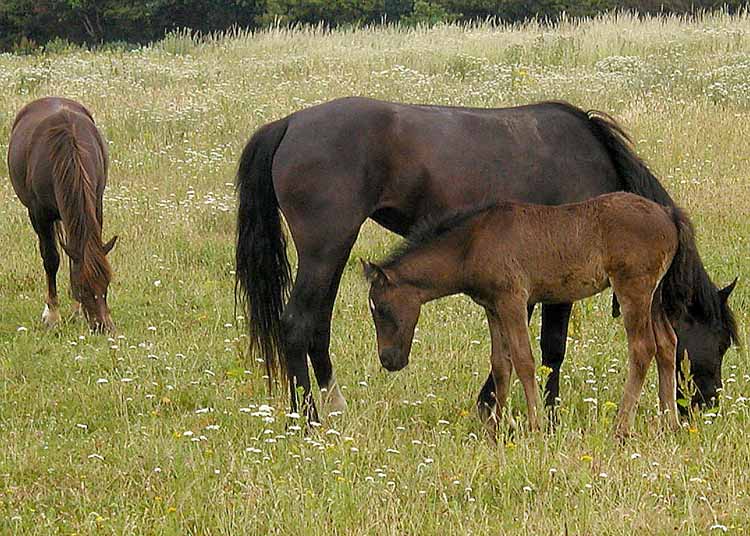
By Steve Zorn
Last week, three of the leading Kentucky thoroughbred stallion farms –Ashford Stud, Spendthrift and Three Chimneys – sued the Jockey Club and the Kentucky Horse Racing Commission, seeking to overturn a new Jockey Club rule that would eventually limit stallion books to a maximum of 140 mares per breeding season. The lawsuit is still in its early stages, but it raises some interesting questions about both the economics and the genetics of thoroughbred breeding.
First, the rule: Jockey Club stud book rule 14C, adopted last May, says that the Jockey Club will register foals produced from only the first 140 mating’s of a stallion each year. If a stallion is bred to more than 140 mares, the excess foals just won’t count as thoroughbreds and will be ineligible to race or breed. The rule goes into effect for foals of 2020 and later, so in practice it would impact first-year sires (then four-year-olds) in the 2024 breeding season. All of the current stallions with large books would be grandfathered in, as would all stallions born earlier than 2020. Here is the statement by the Jockey Club released on February 23, 2021;
In May 2020, The Jockey Club board of stewards announced that it had adopted a final rule limiting the annual breeding of individual stallions. The rule reflects The Jockey Club’s goal to preserve the health of the Thoroughbred breed for the long term. The rule applies prospectively to stallions foaled in 2020 or later; it does not apply to stallions already out to stud.
The Jockey Club publicly proposed a draft rule in September 2019 and received many thoughtful comments, which the stewards carefully considered in formulating a rule that will promote diversity of the Thoroughbred gene pool and protect the long-term health of the breed.
Because the rule applies only to stallions born in 2020 or later, any effect on future stud fees or breeding economics is speculative. The Jockey Club stands by the rule and its purpose, which is to preserve the health of the Thoroughbred breed for the long term. The Jockey Club will continue to maintain the Principal Rules and Requirements of The American Studbook in keeping with its mission to ensure the health of the Thoroughbred breed.
Historically, stallions had smaller books of mares than they do today. As recently as 1991, there was only a single stallion, Alydar, who covered more than 100 mares. By 1996, that number had grown to 14, and a decade later, to 128. Last year, 90 different stallions covered 100 or more mares each, and 42 of those covered more than the prospective Jockey Club limit of 140. At first glance those numbers suggest that stallion concentration is decreasing, but that’s misleading; in the same period (2006-2020), the US thoroughbred foal crop has declined by roughly 43%, from about 35,000 to 20,000 new foals per year. So, relative to the total horse population, the concentration of breeding among the few commercially successful stallions has actually increased even as overall foal crops have declined.
At the upper end of the stallion market, a dozen horses drew 200 or more mares last year: Audible, Constitution, Goldencents, Into Mischief, Justify, Mendelsohn, Mitole, Munnings, Omaha Beach, Palace Malice, Uncle Mo and Vino Rosso. Those elite, and very profitable, stallions stand at just four Kentucky farms, three of which –Ashford (owned by the Irish colossus Coolmore), Spendthrift and Three Chimneys – are the plaintiffs in the new lawsuit. (Audible and Constitution stand at WinStar Farm, which did not join the legal action.) The complaint filed by the plaintiffs in the suit alleges that, if the 140-mare rule had applied to all stallions in 2020, it would have cost some $85 million in stud fees, a very large proportion of which would have been on the ledgers of those three farms.
When the Jockey Club first proposed the new rule, in September 2019, it said the purpose was to reverse the recent trend toward decreasing genetic diversity among thoroughbreds. Presumably more genetic diversity makes for a healthier overall population. Perhaps surprisingly, there are only a few scientific studies that are on point. In promulgating the rule, the Jockey Club relied principally on a 2011 study in the journal Animal Genetics that found a rapid increase in inbreeding from the mid-1990s on, as the books of fashionable stallions grew in size. More recently, a worldwide study by researchers at the University of California-Davis and at PlusVital Genetics in Ireland, published in Nature: Scientific Reports, found continuing increases in inbreeding through the first two decades of this century; for example, 97% of all registered thoroughbreds now have some Northern Dancer in their pedigrees, and there are very high concentrations of the A. P. Indy and Sadler’s Wells lines as well (plus Danehill in the Southern Hemisphere).
But does inbreeding matter? There are good scientific studies showing the dangers of inbreeding, especially susceptibility to disease and birth defects, in cows and pedigreed dogs, but not such good evidence for horses. We do know that thoroughbreds haven’t gotten any faster in recent decades, even as genetic diversity declined, and we know that the average racing career of thoroughbreds has actually declined significantly; the average race horse ran only five times in 2020, compared to eight races per horse in 1990. But other factors may be in play as well: trainers don’t want to run their horses as often for fear of hurting their win percentages; Lasix, not widely used before 1990, requires longer recovery times between races; the economics of breeding vs. racing lead to horses being retired earlier, etc. And in any event, thoroughbreds, descended from just three original stallions in the 18th Century, are never going to show great genetic diversity. The best we can say, given the very limited evidence, is that, though the Jockey Club’s case for greater genetic diversity has considerable intuitive appeal, it has not yet been proven.
The plaintiffs make three broad arguments in their lawsuit: (1) the delegation of stud book responsibilities to the Jockey Club by the Kentucky Horse Racing Commission (and by every other state racing authority in the US) was an unconstitutional delegation of power from a government agency to a private entity; (2) the new stallion-book rule violates the due process and equal protection guarantees of the Kentucky and US Constitutions by depriving the farms of potential income; and (3) the new Jockey Club rule violates the federal Sherman Antitrust Act and the state Consumer Protection Act by interfering with commerce. Plaintiffs’ argument that their revenues are being affected is not quite accurate, at least not in the near term, since existing stallions with large books of mares aren’t affected by the rule, which will apply only to new stallions entering stud in 2024 and after. In fact John Sikura of Hill n’ Dale, perhaps thinking of a stallion he might one day acquire, has criticized the new rule for discriminating against farms like his that do not currently stand any mega-stallions (though Hill ‘n Dale does have Good Magic and Kantharos, who were marginally above 140 mares last year.)
And the Jockey Club is itself not without conflicts here. As the plaintiffs point out, the nine Jockey Club Stewards who promulgated the new rule include a number of people with business interests in racing that might compete with the interests of Ashford, Spendthrift and Three Chimneys. Moreover, as a private entity, the Jockey Club is not subject to the full range of administrative procedures that would apply to a state agency making rules for racing. The Jockey Club did, however, have a public comment period on the proposed rule before it was adopted, much like a state agency would do before adopting new regulations. It may also be relevant to this lawsuit that the new federal racing legislation, the Horseracing Integrity and Safety Act adopted at the end of last year, delegates a lot of enforcement to a private entity, the US Anti-Doping Agency, but requires that the actual rules be adopted by the Federal Trade Commission, a public entity subject to all the normal administrative safeguards.
I have no idea how the US District Court in Lexington will ultimately rule, but the lawsuit does highlight the increasing economic concentration in the breeding industry, at a time when overall US racing is stagnant at best. The Jockey Club’s stallion rule may not be a perfect solution, but it does point to discussions we should all be having.
Photo Credit: User Arpingstone on en.wikipedia – Self-photographed



